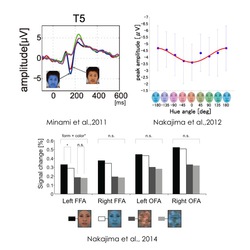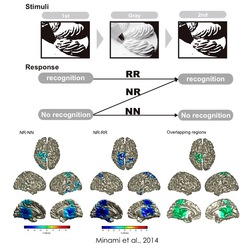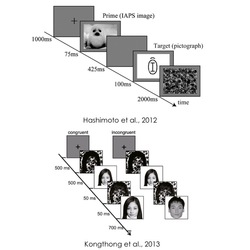
Minami, Tetsuto
| Affiliation | Department of Computer Science and Engineering |
|---|---|
| Concurrent post | Center for IT-Based Education (CITE) Information and Media Center Institute for Research on Next-generation Semiconductor and Sensing Science (IRES²) |
| Title | Professor |
| Fields of Research | Cognitive Neuroscience |
| Degree | Ph.D. |
| Academic Societies | SfN |
| minami@ Please append "tut.jp" to the end of the address above. |
|
| Laboratory website URL | https://sites.google.com/site/minamicnt/ |
| Researcher information URL(researchmap) | Researcher information |
Research
The Cognitive Neurotechnology Unit (CNt) aims to advance fundamental knowledge of human cognitive and emotional processing by measuring human cognitive behaviors and biological signals, such as EEG and pupillometry, and analyzing them with computational techniques. We are also conducting applied research on the obtained knowledge for brain-machine interface (BMI) and neuromarketing. Our laboratory is equipped with EEG systems (Biosemi ActiveTwo) and eye-tracking systems(Eyelink 1000, and SMI RED500). Why don't you measure human beings together with us to find out why various cognitions happen to you?
Theme1:face processing
Overview
Facial color is important information for our social communication, because it provides important clues to recognize someone’s emotion and health condition. Our previous EEG study shows that face sensitive ERP component (N170) is modulated by facial color, which suggests that face color is important for face detection (Minami et al. 2011). Moreover, facial color sensitivity of N170 was found at the left occipito-temporal site (Nakajima et al. submitted). Although the EEG study suggests that N170 at the left occipito-temporal site is related to facial color processing, it has been controversial issue which brain region is involved in facial color processing, because EEG measurement has low spatial resolution. Therefore, the present study will examine the brain regions related to facial color processing by using functional magnetic resonance imaging (fMRI) with higher spatial resolution.
Publications
Nakajima K, Minami T*, Tanabe HC, Sadato N, Nakauchi S. Facial color processing in the face-selective regions: an fMRI study. Hum Brain Mapp. 2014 Sep;35(9):4958-64
Nakajima K*, Minami T, Nakauchi S. The face-selective N170 component is modulated by facial color. Neuropsychologia 2012;50(10):2499-505.
Minami T*, Goto K, Kitazaki M, Nakauchi S. Effects of color information on face processing using event-related potentials and gamma oscillations. Neuroscience 2011;176:265-73.
Keywords
Theme2:Information processing and Insight
Overview
For user-kindly information technology, information should be controlled and selected depending on our brain states. For this purpose, we must know users’ understanding of information. Our previous study is to estimate whether a subject recognized an object or not through a single-trial analysis of EEG, ambiguous or clear state. Six subjects (mean age was 22 years) participated in the experiments. A pool of 120 paired pictures was used for the experimental task. One is an original color image (CI) and the other is the binarized picture (BI). A classification result revealed a good discrimination with the accuracy greater than 90% (Noritake, Minami and Nakauchi, 2009). In the next, I intend to investigate the dynamics of brainstorm: the transition process from ambiguous to clear state. In addition, we will develop applied system enabling real-time estimation of the level of understanding.
Publications
Yokota Y, Minami T*, Naruse Y, Nakauchi S. Neural processes in pseudo perceptual rivalry: An ERP and time-frequency approach. Neuroscience, 2014 Jun 20;271:35-44.
Minami T*, Noritake Y, Nakauchi S. Decreased beta-band activity is correlated with disambiguation of hidden figures. Neuropsychologia, 2014 Apr;56:9-16.
Keywords
Theme3:Neurocommunication
Overview
The affect misattribution procedure (AMP) was proposed as a technique to measure an implicit attitude to a prime image. In the AMP, neutral symbols (e.g., a Chinese pictograph, called the target) are presented, following an emotional stimulus (known as the prime). Participants often misattribute the positive or negative affect of the priming images to the targets in spite of receiving an instruction to ignore the primes. The AMP effect has been investigated using behavioral measures; however, it is difficult to identify when the AMP effect occurs in emotional processing?whether the effect may occur in the earlier attention allocation stage or in the later evaluation stage. In this study, we will examine the neural correlates of affect misattribution, using event-related potential (ERP) dividing the participants into two groups based on their tendency toward affect misattribution.
Publications
Kongthong N, Minami T*, Nakauchi S. Gamma oscillations distinguish mere exposure from other likability effects. Neuropsychologia 2014 Feb;54:129-38.
Kongthong, N., Minami, T.* and Nakauchi, S.(2013), Semantic processing in subliminal face stimuli: An EEG and tDCS Study, Neuroscience letters, Vol.544 No.7, pp141?146.
Hashimoto, Y., Minami, T*. and Nakauchi, S., Electrophysiological differences in the processing of affect misattribution, PLoS ONE 7(11): e49132 (2012)
Keywords
Title of class
Numerical analytics
Databas




